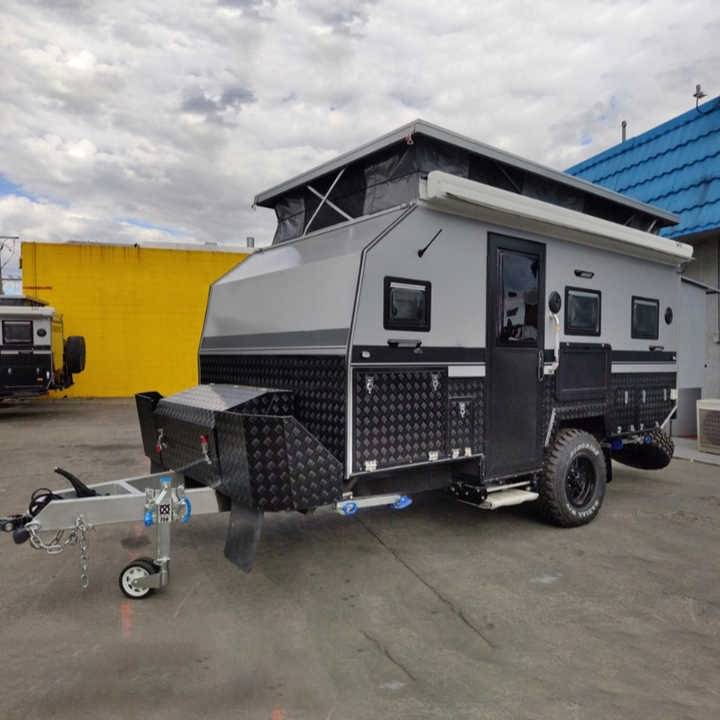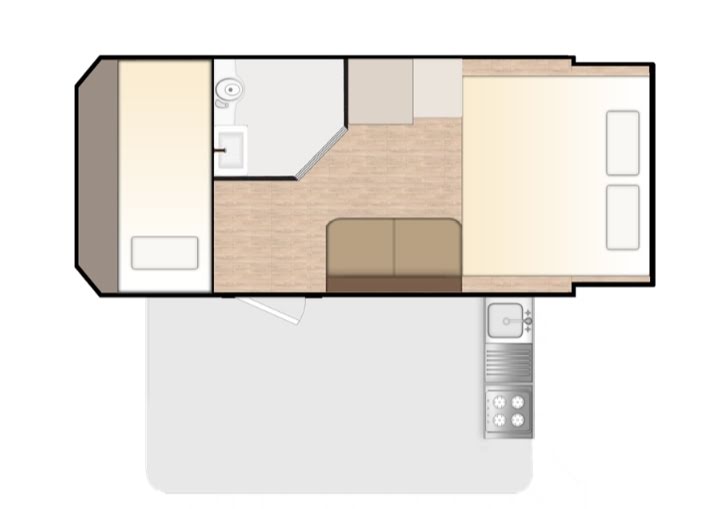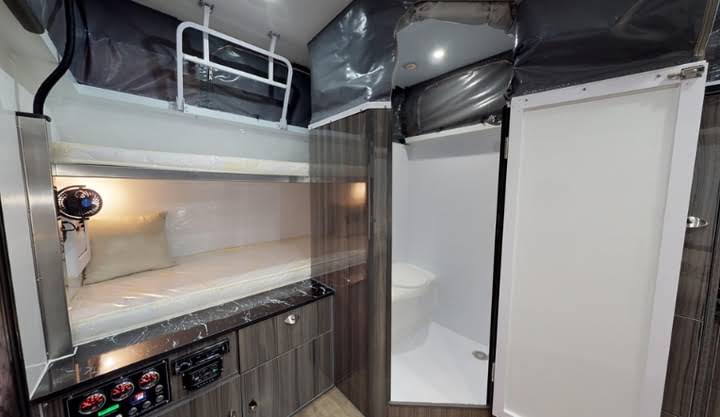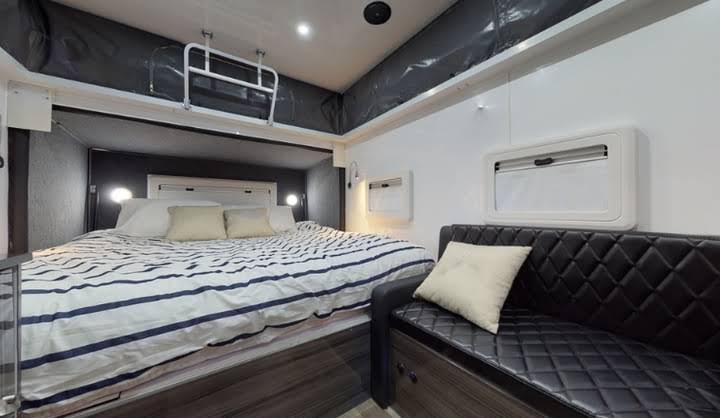Essential Tips for Buying a Second-Hand Pop-Up Trailer
Purchasing a pre-owned camper trailer can be a clever way to relish the great outdoors without spending a fortune.
There are numerous excellent deals available on a used pop-up trailer, but it’s essential to remain vigilant.
Ensure you check for safety features such as compliance plates and proper wiring. Pay close attention to the build quality, as certain trailers might not meet required standards.
With thorough inspection and the right advice, you can secure a dependable pop-up trailer that perfectly fits your needs.
Key Takeaways
Bring important tools like a torch and multimeter for checking a used pop-up trailer. These tools help find problems and confirm things work well.
Look up various camper types and decide your spending limit first. Knowing your needs and budget helps you choose wisely.
Carefully check the trailer’s outside and inside. Look for leaks, damage, and appliance condition to prevent expensive fixes later.

Pre-Inspection Preparation
Essential Tools and Items
Before checking a used pop-up camper, gather helpful tools. A simple tool kit is useful for small fixes. Use a flashlight to spot leaks or pests in dark spots. A ladder helps you safely check the roof and slide-outs. Bring a multimeter to test electrical parts and a thermometer for the fridge and HVAC.
You’ll also need some everyday items. A coffee mug and skillet can test the microwave and stove. Use a water bottle to see if the microwave heats well. For outlets, a GFCI tester is very important. Carry a pen and paper to write notes during the check. Lastly, stay calm and focused. Avoid rushing or making emotional choices.
Tool/Item | Purpose |
|---|---|
Flashlight | To check dark spots for leaks or pests. |
Ladder | To safely inspect the roof and slide-outs. |
Multimeter | To test battery voltage and electrical systems. |
Coffee Mug | Used to test the microwave; must be microwave-safe. |

Researching Used Camper Models
Research is very important when buying a second-hand camper. First, decide what features you need.
Do you want a lightweight camper or one with more storage? Look up popular models and read reviews from other buyers.
Reports like the Camper Trailers Market Report can show trends and buyer favourites.
The Ultimate Caravan & Camper Buyer’s Guide says to focus on your budget and key features.
Inflation has made used campers more popular, as noted in the California RV Resale Market Insights.
This means there are many affordable options, but competition is higher. Take your time to compare models and pick one that fits your needs.

Setting a Budget and Understanding Market Trends
Setting a budget is very important. Decide how much you can spend before shopping.
Study market trends to know fair prices. The Bureau of Economic Analysis says inflation has steadied used camper sales, making now a good time to buy.
Check online listings to see price ranges. Look for seasonal trends too. Prices may drop in the off-season, giving you better deals.
Remember, a well-kept camper might cost more now but save money later.
Exterior Inspection Tips
When you're buying a second-hand pop-up trailer, the exterior condition is just as important as the interior.
A thorough inspection can save you from unexpected repairs down the road. Here are some tips to help you evaluate the outside of the camper.
Assessing the Roof and Seals
Start by giving the roof your full attention. A damaged roof can lead to costly repairs, so this step is crucial.
Use a ladder to get a closer look and check the roof for potential leaking. Look for cracks, soft spots, or any signs of water damage. Pay special attention to the seals around vents, skylights, and edges.
If the seals look cracked or worn, they might need replacing.
Run your hand along the edges of the roof to feel for any gaps or loose areas. If you notice any sagging, it could indicate structural issues.
Don’t forget to inspect the corners, as these are common trouble spots. A well-maintained roof is a good sign that the camper has been cared for properly.
Tip: Bring a flashlight to spot hidden damage, especially if you're inspecting in low light.
Inspecting Tyres and Wheels
The tyres and wheels are your camper's lifeline on the road. Worn-out tyres or damaged wheels can lead to dangerous situations.
Start by checking the tyre tread depth. If the tread is too shallow, the tyres will need replacing.
Look for cracks, bulges, or uneven wear, which could indicate alignment issues.
Next, inspect the wheels for rust or dents. Spin each wheel to ensure it moves smoothly. Don’t forget to check the lug nuts—they should be tight and free of rust. If the tyres look old or the wheels seem neglected, factor the cost of replacements into your budget.
Note: Tyres older than six years, even if they look fine, should be replaced for safety reasons.
Examining the Chassis and Underbody
The chassis is the backbone of your pop-up trailer, so its condition is critical. Get down low and check under the chassis for rust.
Surface rust is common and usually harmless, but deep rust or corrosion can weaken the structure. Pay close attention to the joints and welds, as these areas are more prone to damage.
While you're under there, look for any signs of leaks or damage to the underbody. Check the suspension components for wear and tear. If you notice anything bent or broken, it could mean the camper has been in an accident or poorly maintained.
Pro Tip: Use a small mirror to inspect hard-to-reach areas under the chassis.
By following these tips, you’ll have a clearer picture of the pop-up trailer’s overall condition. A solid exterior is a strong foundation for a reliable camper.
Interior Inspection Tips
When you’re buying a second-hand pop-up trailer, the interior deserves just as much attention as the exterior. A well-maintained interior can make your camping trips more enjoyable and save you from costly repairs. Here are some tips to help you inspect the inside of the camper thoroughly.
Checking the Canvas and Screens
The condition of the canvas is one of the most important things to check. Start by unzipping and unfolding the canvas completely. Look for tears, holes, or signs of mould. If the canvas feels brittle or smells musty, it might need replacing. Pay close attention to the seams and stitching, as these areas are prone to wear and tear.
Don’t forget the screens. Open all windows and inspect the mesh for rips or fraying. Damaged screens can let insects in, which is the last thing you want during a camping trip. If you spot any issues, ask the seller if repairs have been made or if replacements are available.
Tip: Bring a torch to check the canvas in darker areas. Shine the light through the material to spot hidden holes or weak spots.
Inspecting Appliances and Fixtures
Appliances and fixtures play a big role in the functionality of your camper. Start by testing the fridge, stove, and microwave. Plug them in or turn them on to ensure they work properly. For the fridge, use a thermometer to check if it cools to the right temperature. Heat a small pan on the stove to confirm it’s operational.
Next, inspect the sink and taps. Turn on the water to check for leaks or low pressure. Open and close all cupboards and drawers to ensure they slide smoothly. Look for loose hinges or broken handles. If the camper has a heater or air conditioner, test them to see if they’re in working condition.
Pro Tip: If the camper has a water heater, ask the seller to demonstrate its functionality. Repairs for water heaters can be expensive.
Evaluating Flooring and Storage Areas
The flooring is another key area to inspect. Walk across the entire floor and feel for soft spots or uneven areas. Soft spots could indicate water damage or structural issues. Check the corners and edges for signs of rot or peeling.
Storage areas are equally important. Open every compartment and inspect for cleanliness and damage. Look for signs of pests, such as droppings or chewed materials. If the storage areas smell damp, it could mean there’s a moisture problem.
Note: Bring a small mirror to check inside hard-to-reach storage compartments.
By following these tips, you’ll get a clear picture of the camper’s interior condition. A well-kept interior ensures a comfortable and hassle-free camping experience.

Functional Checks for Pop-Up Trailers
When buying a used pop-up trailer, testing how it works is key. These tips will help you check everything properly.
Testing Electrical and Lighting Systems
First, inspect the camper’s electrical system. Look at wires and cables for cracks or damage. Even small cracks can let water in and cause problems later. Pay close attention to where wires connect, as rust here is a bad sign. If the trailer has old bulbs, think about switching to LED lights. LEDs last longer and work better.
Test all the lights inside and outside. Turn them on and off to see if they work well. Flickering or dim lights might mean wiring or battery issues. Use a multimeter to check the battery’s voltage and ensure it holds power.
Tip: Test gas or electric appliances too. Broken ones can be expensive to fix.
Verifying Brakes and Suspension
Brakes and suspension are important for safe towing. Start by testing the brakes. If the trailer has electric brakes, connect it to a tow vehicle and check if they work. Listen for strange sounds like squeaks or grinding, which could mean wear.
Next, check the suspension. Look for worn parts or sagging. Push down on the trailer to see if it bounces back smoothly. If it feels stiff or uneven, the suspension might need fixing. Good suspension makes towing safer and smoother.
Ensuring Stabilisers and Lift Systems Work
Stabilisers and lift systems help set up your camper. Extend and retract the stabilisers to check if they move easily. If they’re stiff or rusty, they might need oiling or replacing. Test the lift system by raising and lowering the roof. Listen for grinding sounds or resistance, which could mean mechanical problems.
Pro Tip: Check the gas bottle and connections for safety. Faulty ones can be dangerous and might not meet standards.
By following these steps, you’ll know if the pop-up trailer works well. A working camper means fewer problems and more fun trips.
Documentation Review Tips
When buying a second-hand pop-up camper, checking the paperwork is very important. Proper documents make sure your purchase is legal and safe. Follow these tips to review the camper's documentation.
Confirming Ownership and Title
First, check who owns the camper. Make sure the title is clear and has no debts or claims. You don’t want to buy a camper with unpaid loans. Ask the seller for a signed bill of sale as proof of purchase. Use the VIN (Vehicle Identification Number) to confirm the camper’s details. This check also helps find any mistakes in the paperwork.
Important: Always verify ownership and registration details before buying. Local authorities can help confirm the title and other records.
Reviewing Maintenance Records
A camper with good care lasts longer. Ask the seller for maintenance records. These show how well the camper was looked after. For example, one owner praised their Hallmark Milner 6.5 camper for lasting ten years. They said regular maintenance kept it reliable. Look for records of repairs, servicing, or upgrades. If the seller doesn’t have these, it could be a warning sign.
Ensuring Compliance with Regulations
Every camper must follow local rules to be safe on the road. Check if the camper meets safety and emissions standards. Ask for proof of emissions tests and valid registration. Some places need temporary plates or tax receipts for registration. Confirm these to avoid problems later.
By following these steps, you’ll know your pop-up camper is legal and ready for your trips.
Questions to Ask About Pre-Loved Camper Trailers
Knowing Why the Seller is Selling
Ask the seller why they are selling the camper. Their answer can tell you about its condition. If they say they’re upgrading or downsizing, it might be in good shape. But if they mention problems or repairs, look into it further.
Don’t be afraid to ask more questions. For example, “How often did you use it?” or “Did it give you any trouble?” These questions can show how well it was cared for. Sellers who are honest about their reasons are usually more reliable.
Tip: If the seller avoids answering, it could be a warning sign.
Asking About Repairs or Changes
Repairs and changes can affect a camper’s value and safety. Ask if the seller made any updates, like fixing the roof or changing the canvas. Some changes are helpful, but others might cause problems.
Also, ask about past repairs. Questions like, “Did the roof ever leak?” or “Was it in any accidents?” can reveal hidden issues. A camper with many repairs might not be the best choice.
Pro Tip: Check for maintenance records to confirm what the seller says. A record of care shows the camper was looked after.
Finding Out About Use and Storage
How the camper was used and stored affects its condition. Ask where the seller travelled. Did they stay on smooth roads or go off-road? Off-road use can cause more wear.
Storage matters too. Ask if the camper was kept inside or outside. Sun, rain, and snow can damage it over time. Questions like, “Was it covered when stored?” or “How often was it cleaned?” can give you useful details.
Note: Campers stored indoors or under covers are usually in better condition.
By asking these questions, you’ll learn more about the camper’s history. This will help you decide wisely and avoid problems later.
Buying a second-hand pop-up trailer can be exciting if done right. Check the canvas, screens, and electrical parts to avoid big repairs. Look for water damage and test the pop-up system before buying. Learn about the camper’s history and weight to see if it fits your needs.
When discussing price, decide your budget and stick with it. Offer a fair price based on research and the trailer’s state. Be firm but willing to adjust if needed. If something seems wrong, don’t be afraid to walk away. These steps will help you find a dependable camper for your trips.
Remember: Careful checks and smart bargaining can save you trouble later and help you get great value.
FAQ
What are common problems in used pop-up trailers?
Look for water damage, old tyres, and broken lift systems. These issues happen often. Careful checks can help you avoid trouble.
How can I tell if a camper’s price is fair?
Check similar ads online. Think about its age, condition, and features. Knowing market trends will show if the price is good.
Any advice for bargaining with the seller?
Yes! Stay polite but firm. Point out any problems you find. Use these to explain why you’re offering less, without being rude.
See Also
Essential Factors to Consider for Folding Camping Trailers
Best Advice for Selecting Your Perfect Tent Trailer
Three Important Considerations for Mini Trailers from China
Guidelines for Selecting Budget-Friendly Folding Camping Trailers
